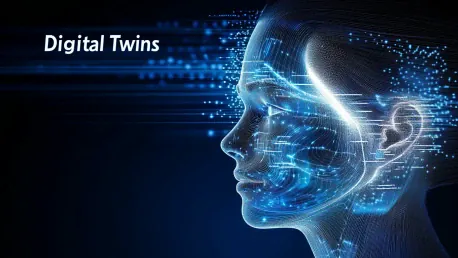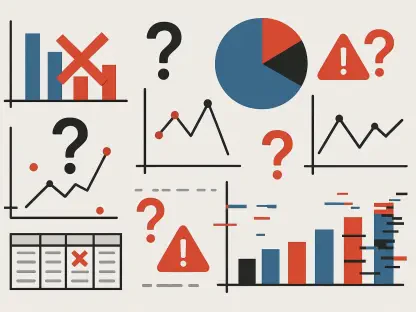The article explores how digital twins and generative AI (genAI) are poised to revolutionize app development in 2025, particularly in the realm of real-time system management. Dr. Bain, founder and CEO of ScaleOut Software, draws on his extensive 40-year career in parallel computing to predict that these technologies will fundamentally enhance the way applications deliver live insights, improve user interactions, address AI errors, and accelerate workflows.
The Transformative Potential of Digital Twins and GenAI
Enhancing Real-Time Insights and User Interactions
Digital twins, which are virtual models designed to replicate and manage complex physical systems, can provide dynamic, data-rich insights that are unparalleled by other techniques. When paired with genAI, these insights can be harnessed to optimize and manage operations more effectively across a variety of applications. Digital twins enable continuous, context-based analytics by processing live data from diverse sources. This capability allows for real-time anomaly detection and dynamic visualizations that help users gain deeper understanding and actionable intelligence about live operations.
For instance, an app designed for managing large-scale retail operations could use digital twins to monitor inventory levels, supply chain data, and in-store activity. By integrating genAI, the app could predict inventory shortages before they occur, generate targeted restocking suggestions, and alert managers to emerging sales trends. The AI-powered data visualizations would aid decision-makers in responding quickly and accurately to opportunities or challenges. The ability of a digital twin to process real-time data and respond to changing conditions dynamically ensures that retail operations remain efficient and proactive.
In addition to retail, digital twins paired with generative AI can transform other industries such as healthcare, transportation, and manufacturing. For example, in healthcare, a digital twin of a hospital’s operations could provide real-time data on patient flow, staff availability, and equipment usage. GenAI could then use this data to predict patient admission surges, optimize staff schedules, and ensure that critical equipment is available when needed. This level of precision and responsiveness is only possible through the integration of digital twins and genAI.
Streamlining App Development with GenAI
GenAI will streamline the creation of digital twin applications, enhancing the development process by automating routine coding tasks, solving specialized challenges, and optimizing designs. This automation allows developers to focus on strategic design and problem-solving rather than getting tangled in technical details. For example, an energy management app using digital twins to monitor a city’s power grid could benefit from AI that automates the development of algorithms to track energy consumption trends, identify anomalies, and recommend load-balancing strategies.
This approach not only reduces development time but also delivers robust features for management personnel. Streamlined development processes mean that sophisticated applications can be built faster, with fewer resources, and with greater reliability. This ensures that companies can deliver more advanced and efficient apps to the market while maintaining high standards of quality and functionality. The ability to automate routine coding tasks also allows developers to dedicate more time to innovation and strategic planning.
Moreover, as digital infrastructure continues to evolve, the integration of genAI in app development will become increasingly essential. Applications that once required extensive manual coding and supervision will now leverage AI’s ability to automate and optimize. For instance, an autonomous vehicle system could benefit from AI-driven algorithms that constantly analyze traffic patterns, predict potential hazards, and optimize routes. This not only enhances safety but also improves the overall efficiency of transportation systems.
Addressing AI Errors and Enhancing Trust
Mitigating Common GenAI Issues
The article addresses common issues associated with genAI, such as hallucinations, biases, and data misinterpretations, which can undermine trust and disrupt decision-making. Digital twins can mitigate these problems by providing genAI models with live, accurate data via a process known as Retrieval-Augmented Generation (RAG). This method ensures that AI models query real-time information, refine their outputs, and minimize inaccuracies. For example, an airline app could use digital twins to provide real-time data on flights, passengers, crews, and gates, allowing genAI to generate accurate and timely recommendations.
This integration ensures that the AI’s outputs are grounded in reality, thereby enhancing trust and reliability. By leveraging digital twins, genAI can offer more precise and contextually relevant insights. This is particularly crucial in industries where real-time data accuracy is paramount. The combination of digital twins and genAI ensures that applications can provide immediate insights, enhance situational awareness, and adapt to evolving challenges.
The importance of integrating reliable data sources in AI models cannot be overstated. Trustworthy outputs from AI systems depend heavily on the quality and timeliness of the data they process. By incorporating real-time data from digital twins, genAI systems can avoid many pitfalls associated with traditional AI systems. This approach is transformative for sectors like finance, where timely and accurate data is essential for making informed decisions. Financial apps, for instance, using digital twins to monitor market conditions, could provide real-time investment recommendations, thus improving the accuracy and relevance of financial advice.
Ensuring Accurate and Timely Recommendations
By leveraging digital twins, genAI can offer more precise and contextually relevant insights. This is particularly crucial in industries where real-time data accuracy is paramount. The combination of digital twins and genAI ensures that applications can provide immediate insights, enhance situational awareness, and adapt to evolving challenges. For example, in healthcare, a digital twin of hospital operations can provide data on patient flow, staff availability, and equipment usage. GenAI could then use this data to predict patient surges, optimize staff schedules, and ensure equipment availability when needed. This precision and responsiveness are possible only through integrating digital twins and genAI.
The ability to generate accurate and timely recommendations can significantly enhance operational efficiency and decision-making processes in various sectors. For instance, in transportation, real-time monitoring of traffic conditions combined with AI-driven predictive analytics can optimize route planning and reduce congestion. Logistics companies can also benefit from such integrations by ensuring that goods are delivered on time while minimizing fuel consumption and operational costs. Moreover, as technology continues to evolve, the integration of digital twins with genAI will become increasingly vital for developing sophisticated, efficient, and reliable applications across different fields.
Similarly, the gaming industry could see revolutionary changes as developers incorporate digital twins and AI to create hyper-immersive environments. Games that adapt in real-time to players’ actions and environmental changes could become the norm, offering gamers a level of interaction and immersion previously unimaginable. The combination of digital twins and AI allows for continuous adaptation and improvement of game mechanics and user experience, promising a future where the virtual worlds of games are as dynamic and responsive as the real world.
Accelerating Workflows and Enhancing Operational Efficiency
Reducing Development Time and Enhancing Features
The integration of digital twins and genAI not only enhances app functionality but also accelerates the development process. By automating routine tasks and providing real-time data, developers can create more sophisticated applications in less time. For example, a logistics app could use digital twins to monitor fleet movements, traffic conditions, and delivery schedules. GenAI could then automate route optimization, predict potential delays, and suggest alternative routes. This not only improves operational efficiency but also ensures timely deliveries, enhancing customer satisfaction.
Automating the routine aspects of app development with genAI allows developers to concentrate on more high-level, strategic elements of design and problem-solving. This shift in focus can considerably improve an application’s overall quality and user experience. For example, in urban planning, digital twins can model city infrastructure, integrate real-time data such as traffic patterns and public transit schedules, and use genAI to optimize city layouts and resources. This leads to smarter, more livable cities, where resources are used more efficiently, and residents’ needs are met proactively.
Using genAI to streamline and enhance app features goes beyond mere efficiency; it can lead to more innovative solutions and advanced functionalities. GenAI can identify problem areas and offer creative approaches, such as suggesting new functionalities that developers might not have considered. This results in richer, more versatile applications. For example, in the field of personalized education, digital twins could monitor student progress and adapt lesson plans in real-time, providing tailored educational experiences based on individual needs. By leveraging the capabilities of genAI, educators could enhance learning outcomes and foster a more engaging, student-centered approach to teaching.
Adapting to Evolving Challenges
As live systems become increasingly complex, the ability to adapt to evolving challenges becomes crucial. Digital twins and genAI provide the tools necessary to manage these complexities effectively. By continuously processing live data and generating actionable insights, these technologies enable applications to respond dynamically to changing conditions. For instance, in the manufacturing sector, a digital twin of a production line could monitor equipment performance, detect potential failures, and recommend maintenance schedules.
GenAI could then use this data to optimize production processes, reduce downtime, and improve overall efficiency. This proactive approach ensures that operations run smoothly and efficiently, even in the face of unexpected challenges. The use of digital twins combined with genAI means apps can quickly adapt to new conditions, thereby reducing downtime and maintaining smooth operations. This is critical for industries where operational disruptions can result in significant financial losses or safety hazards. For example, in the field of autonomous vehicles, real-time data from a fleet of vehicles can be analyzed to optimize routes dynamically, anticipate maintenance needs, and improve safety protocols.
Embracing digital twins and genAI allows companies to be more resilient and proactive in facing uncertainties and challenges. Moreover, as these technologies continue to advance, they promise even greater levels of efficiency and adaptability. Industries that rely on complex systems and critical real-time data will find that integrating digital twins with genAI not only improves operational efficiency but also fosters innovation and competitiveness. In conclusion, the ability to quickly adapt and respond to changing conditions will become increasingly valuable as industries evolve and face new challenges.
The Future of App Development
Embracing the Trend
This article delves into the transformative potential of digital twins and generative AI (genAI) on app development in 2025, especially in managing real-time systems. Dr. Bain, who is the founder and CEO of ScaleOut Software, leverages his 40 years of experience in parallel computing to forecast how these advancements will drastically change our approach to application functionality. He anticipates that digital twins and genAI will significantly boost live data insights, enhance user experiences, rectify AI-related mistakes, and speed up various processes.
Focusing on real-time management, Dr. Bain argues that digital twins, which are virtual representations of physical systems, paired with genAI, will create a highly responsive and adaptable environment for developers. These technologies are expected to provide unprecedented levels of accuracy and efficiency, leading to smarter and more intuitive applications. In 2025, these innovations aim to streamline workflows and offer solutions that are as close to instantaneous as possible, marking a major leap forward in app development and user interaction.









